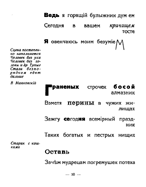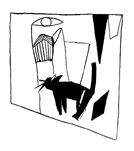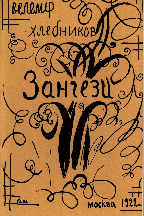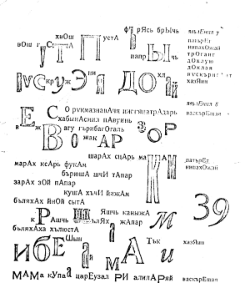Russian Futurism

 Vladimir Mayakovsky, from 'Mayakovsky -- A Tragedy'
(1914)
Vladimir Mayakovsky, from 'Mayakovsky -- A Tragedy'
(1914)
The first use of the word futurism by
a Russian art movement, was by a group known as the (Ego-Futurists) in 1911.
Most of the individuals involved in this group were only 'half-baked'
aestheticisms. A far more radical literary movement in Russia at this time were
the Hylaens. However, in the beginning they did not consider themselves
to be futurists at all. It was only after the decline of the Ego-Futurist group
around 1913, that the Hylaens started to examine a set of ideas that were a
synthesis of Italian Futurism and French Cubism. The
Hylaens were originally organized by a graphic artist by the name of David
Burliuk (1882-1967), who was their F. T. Marinetti. Among the members of this
group was Velimir Khlebnikov (1885-1922), Alexei Kruchenykh (1886-1970), and
the well-known 'Poet of the Revolution,' Vladimir Mayakovsky (1893-1930).
Eventually the Hylaens became known as Russia's only futurist group at
the expense of several other Russian avant-garde cliques who had also existed
at the same time.
Perhaps the greatest 20th century
experimental poet of Russia, as well as the rest of the world, was Velimir
Khlebnikov [1]. While many of his fellow
cubo-futurists were looking towards the West for ideas, he wanted to strip the
Russian language of any Western influences and thereby create a pure Russian
language free from dilution. By finding what he perceived to be the ethnic and
zoomorphic roots in his native language, he transformed it into a completely
plastic and sonic thing. He also wrote poems in zaum, a
transrational, universal, and transmental language created by
Alexei Kruchenykh, which was to be as close to experience as possible. His poem
'Zangezi,' which was a conversation between gods, was perhaps his most
extensive use of zaum.
Velimir Khlebnikov, front
cover of 'Zangezi' (1922).
Though Khlebnikov had developed
zaum to a high degree of intelligence, it was Kruchenykh, who lived and
breathed it. He intended to return to the non-rational and primitive in
language, thereby releasing it from the entanglements of meaning which had
'killed' it. He did this by developing a system of 'poetic irregularities'
which would accent the sounds of language. These techniques would include
'chopped words, half words, and their whimsical, intricate combinations'
[2]. The written texts of his poems included
anarchistic typographical experiments such as capital letters inside of words,
handwritten letters, different font styles, and letters printed upside down.
Kruchenykh attributed his 'primitive coarseness' to 'the influence of African
art' [3], and both he and Khlebnikov developed a
poetry which had more similarity to Dada than to their
Italian Futurist counterparts.
Raoul Hausmann put forth the theory that
Hugo Ball had learned of Khlebnikov's experiments through the Russian artist
Wassily Kandinsky. Kandinsky had performed his Klang poems (which were
not really sound poems as the title suggests) at the Cabaret Voltair in 1916
amidst 'prehistoric howls' from a 'nervous audience' [4]. Kandinsky had made a connection between the
innerer Klang (inner sound) of the soul and that of nature. He was
interested in developing a type of painting which would function the same as
'Musical sound acts directly on the soul and finds an echo there...'
[5]. However, that Kandinsky informed Hugo Ball
about zaum is doubtful, since there is no evidence in Kandinsky's work
that gives any indication that he was ever particularly interested in the kinds
of literary experiments which the Hylaens (and the later Dadaists)
practiced.
 Iliazd, a page from
LidantJU fAram, (1923).
Iliazd, a page from
LidantJU fAram, (1923).
There is an example of Russian Dada however
in the work of Ilya Mikhailovich Zdanevich (1894-1975) [6]. Zdanevich was one of the more clever participants
of the 41° literary group which was founded by Kruchenykh in 1919
to publish, promote and give performances of zaum poetry. Zdanevich
wrote several transrational dra: plays in which he made 'perhaps the
most consistent and large-scale use of zaum in Russian futurist literature
[7].' From the early twenties on, Zdanevich did
artists books and published his works in Paris and Germany under the pseudonym
of Iliazd. He had an important, though somewhat obscure role in the history of
Paris Dada while he lived there as an expatriate [8]. Iliazd was also an early champion of sound poetry
and in 1949 he published one of the first anthologies, Poésie de mots
inconnus, which was a collection of Dadaist sound poetry and Russian
zaum. The main thrust of this publication, was to show the 'derivative
nature' of French Lettrism which had
claimed its uniqueness in a somewhat arrogant manner [9].

Last Modified 23 January 1998

 Vladimir Mayakovsky, from 'Mayakovsky -- A Tragedy'
(1914)
Vladimir Mayakovsky, from 'Mayakovsky -- A Tragedy'
(1914) 
 Iliazd, a page from
LidantJU fAram, (1923).
Iliazd, a page from
LidantJU fAram, (1923).